AMD’s New EPYC 7F52 Reviewed: The F is for ᴴᴵᴳᴴ Frequency
by Dr. Ian Cutress on April 14, 2020 9:45 AM EST- Posted in
- CPUs
- AMD
- Enterprise
- Enterprise CPUs
- EPYC
- SP3r2
- CPU Frequency
- Rome
- 7Fx2
CPU Performance: Rendering and Synthetics
For the rest of our CPU tests, we’re using a mix of rendering and synthetic workloads. This is slightly different to our previous server reviews, due to some adjustments, and we hope to be running something similar to our standard server workloads in the near future.
All CPUs are run with SMT/HT enabled.
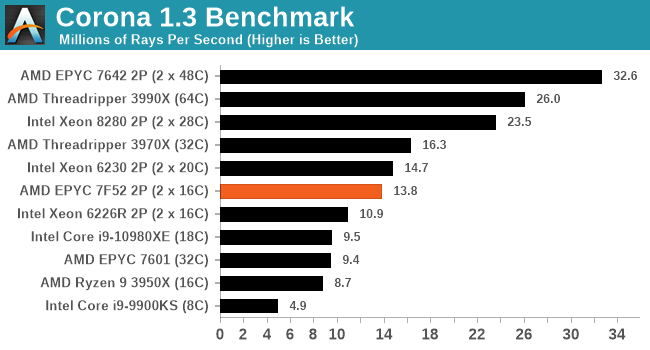
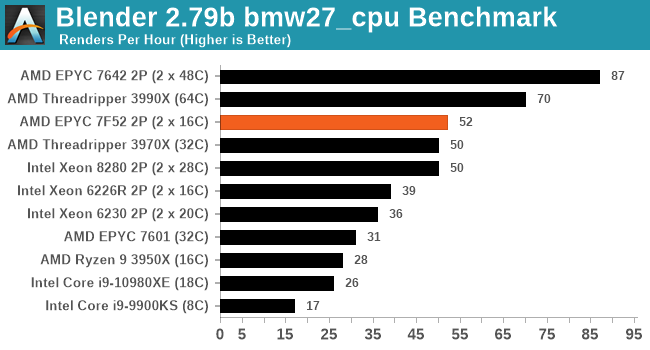
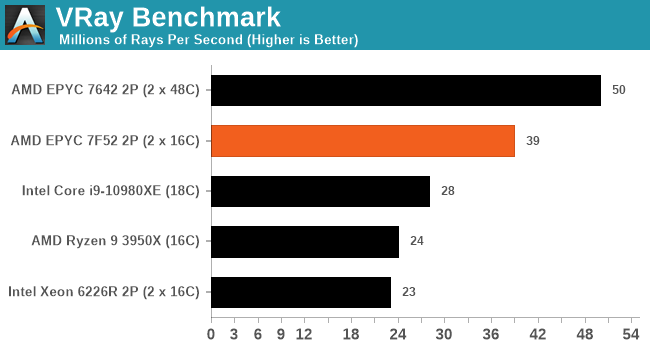
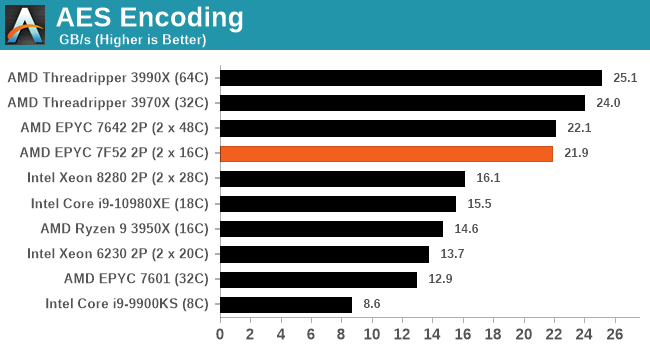
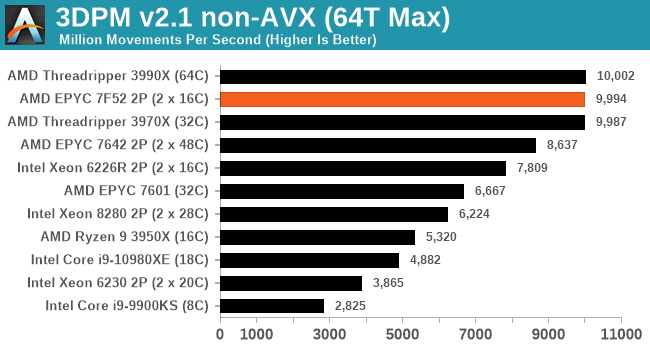
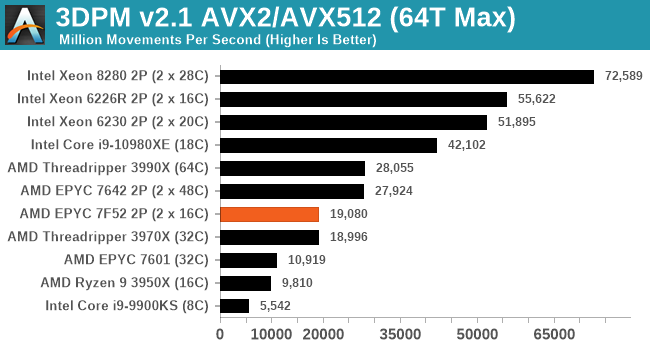
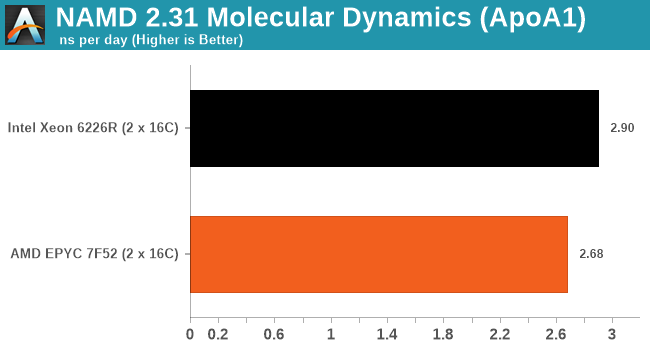

Even with the addition of a socket-to-socket in the mix, the dual 7F52 setup scores up to +100% in some benchmarks over the previous generation EPYC 7601. Against Intel’s latest 16-core Cascade Lake Refresh hardware, the AMD takes a sizeable lead in most benchmarks (except notably AVX512), which is perhaps to be expected given the price difference and power difference. What is interesting is how in certain workloads, the 2P 7F52 setup can make a reach up for the Xeon 8280s, despite the 8280s being 3x the cost each.










97 Comments
View All Comments
Oxford Guy - Saturday, April 18, 2020 - link
" No one in their right mind would evaluate a server CPU, designed for datacenters against a consumer CPU that will never see the light of day. WTB a real data center oriented website.. you consumers are just annoying when it comes to this stuff."Is there any kind of metric about ECC vs. non-ECC RAM, in terms of cost-benefit ratio? It's not all about CPU speed. It's also about data stability, correct?
How much value does ECC RAM bring to the table? That information seems to be critical when comparing consumer CPUs to enterprise and prosumer CPUs.
twtech - Monday, April 20, 2020 - link
Generally that may be the case. However, this CPU may be considered as an option for workstations. For that use case, it's nice to know how it stacks up against consumer CPUs, HEDT, TR, etc.DanNeely - Tuesday, April 14, 2020 - link
Can you borrow Johan's server benchmarks as a baseline for building your own out?Ivan Argentinski - Tuesday, April 14, 2020 - link
Hi Ian,I am big fan of Anandtech. But I have always missed articles, relevant to me. I am a decision maker for database servers for ERP (among other things). We heavily employ frequency-optimized processors and I feel I can shed some light on the subject.
Unfortunately, I feel like the article (and just about everybody) is partially missing the point of these processors. Frequency optimized processors are a niche product. They have only one use-case - for enterprise software, which is licensed per-core (like Microsoft SQL Server). So, it is irrelevant to discuss them in any other role.
Per-core performance is not the same as single-threaded performance. Also, it is not lightly threaded performance. It is also not multi-thread performance, e.g. total CPU power. All these are irrelevant. We pay for SQL Server per core, per month. And it is costly. The CPU cost is nothing, compared to this. However, the total number of frequency-optimized cores we can cram in a server matters to some extent. Hence, the new 7F52 totally makes sense and I guess it will be the best-selling 7Fx2 CPU. If I can get 32 high-per-core-performant cores in a 2P server, it would be great.
For example, our servers are usually 40-70% loaded during peak times of the day (with some 100% bursts). The thing that matters the most is how each core is handling, while all cores are loaded. This can be roughly stated as:
Per-core Perf = Total Perf / Number of cores
Hence, it is meaningless for this niche to:
- Measure single threaded workloads
The CPU can trick us by leveraging single-thread boost, which never happens in production.
- Compare total CPU performance
If the CPUs have different number of cores, this is meaningless. If we need more performance, we can just purchase more CPUs/servers.
- Compare the CPU to non-frequency optimized CPUs
These will just plain loose in per-core performance. But, on second thought, it would be fun to know what the actual difference is!
- Compare to desktop or other kinds of CPUs.
We just can’t use these in the data center. And if you are not purchasing for a data center and for a per-core software, then frequency optimized CPUs are not for you. Again, maybe just for fun.
What if meaningful to compare for F-CPUs:
- Per-core performance
Throw heavy multi-threaded workload, then divide by the number of cores and see what you get for each CPU.
- Watts for a unit of per-core perf
Power is the other thing we are paying for.
- $ for a unit of per-core perf
Not of utmost importance, but still relevant.
Ideas for relevant test scenarios:
- 1P * 7F52
- 2P * 7F52
- 2P * 7F32
- 2P * Gold 6250
- 2P * Gold 6244 (our current setup)
- 2P * Gold 6244, but with less DIMMs than memory channels (if you initially buy with less RAM, how much perf are you loosing?)
Tests, relevant to databases:
- OLTP - tpm
- OLAP - qph
If I have these figures, it can actually alter my purchasing behavior.
Good Luck and all the best to you and the team!
romrunning - Tuesday, April 14, 2020 - link
Agreed - more enterprise-focused tests would be more relevant to this enterprise-focused EPYC.I also would have liked to see VM tests and database tests.
Icehawk - Wednesday, April 15, 2020 - link
Agreed, not quite as relevant for this specific SKU but I’ve been wanting to see VM testing for ages along with a lot of other server related testing like SQL performance. Of course consumer is this site’s focus and that’s OK.Atari2600 - Tuesday, April 14, 2020 - link
Hey Ivan, you prob need to go look at servethehome.comAs I'm sure your well aware, Anand is much more consumer focused with a benchmarking philosophy geared toward that.
Oxford Guy - Saturday, April 18, 2020 - link
What is the point of discussing $7000 CPUs, or even $3000 CPUs if you're only going to be "consumer-focused"?The only point I can think of is to try to convince people to buy some company's other product via mindshare (i.e. marketing).
brucethemoose - Tuesday, April 14, 2020 - link
Could you link those 2 benchmarks?Ian Cutress - Tuesday, April 14, 2020 - link
Hey Ivan,Thanks for the input, it means a lot. This was a rush review for sure, I had to pool some data and retest some as well. Unfortunately our stock of enterprise CPUs isn't great - I don't have the 7371 frequency optimized ones from the previous generation, nor any of Intel's. I'll be getting the 7F32 and 7F72 parts in soon though, so perhaps I can work a bit more to that.
I also need to do some research into developing these benchmarks. Some serious 'explain it like I'm a five-year-old' guides of what to download from where, how to install it, what commands to run, etc. I also want some proper system power monitoring tools. The usual fare that US reviewers use, like Watts Up units, aren't sold outside the US, and I've been after something for a while.
I'll certainly take heed of the metrics that users like yourself require, and work them into future reviews as I can.